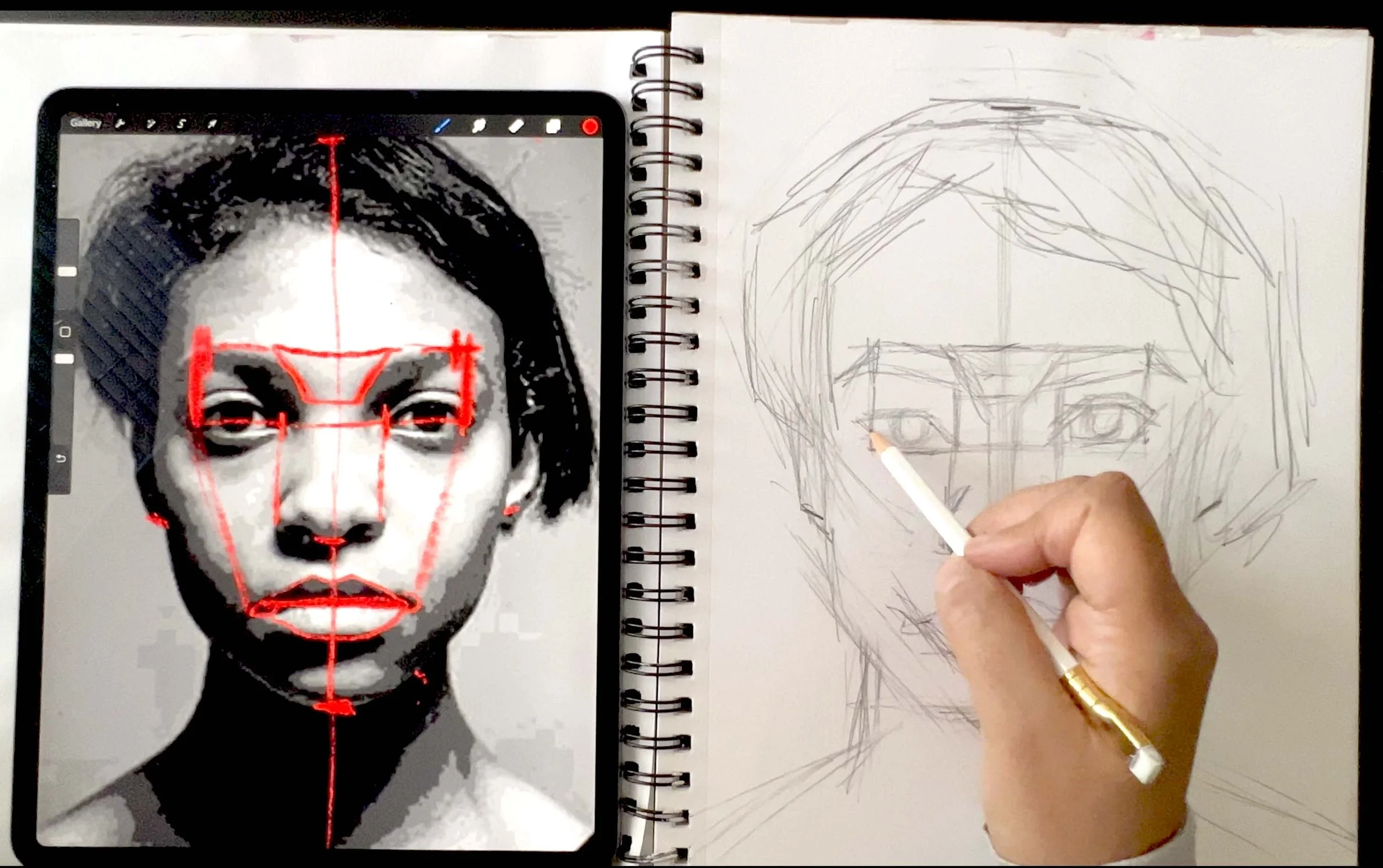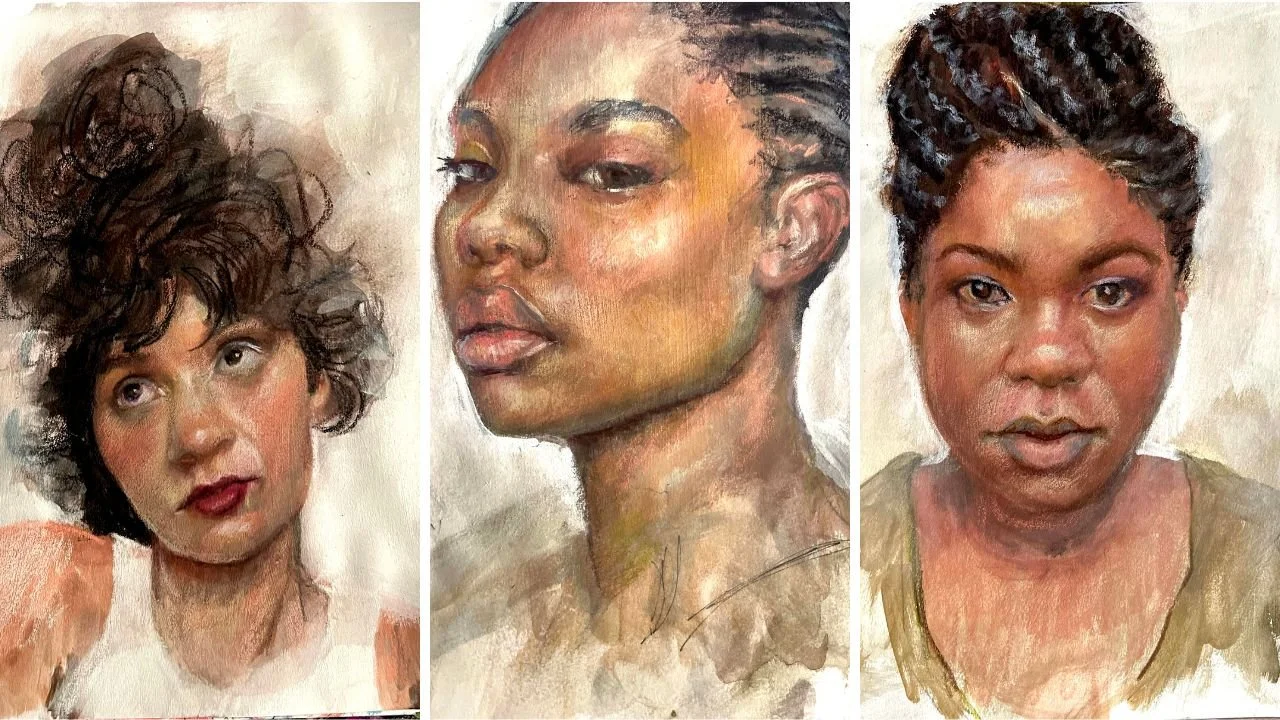
A GREAT START FOR THE BEGINNER PORTRAIT PAINTER
COLOR MIXING MADE EASIER
ARE YOU FEELING OVERWHELMED
WITH TOO MANY PAINT COLORS?
Let’s Fix That Today!
Supplies I am using:
ZORN PALETTE - Titanium White, Yellow Ochre, Cadmium Red Light, Ivory Black, (I am using Oil Paint)
My Everyday portrait painting Palette: Titanium White, Yellow Ochre, Indian Yellow, Cadmium Red Light, Quinacridone Rose, Alizarin Crimson, Burnt Sienna, Raw Umber, Ultramarine Blue, Viridian, Ivory Black (I am using Oil Paint)
NOTE: My palette is the same for both acrylic and oil paint.
Glass Palette or disposable palette
Your Palette Is Your Creative Fingerprint
Your painting palette is more than just a collection of colors, it’s a reflection of you. The hues you’re drawn to, the way you mix them, and how they show up in your work become part of your creative fingerprint. Over time, your palette evolves into something uniquely yours. A quiet signature woven into every brushstroke. It tells a story about how you see the world and express what you feel.
Choosing your colors with intention helps you build trust in your voice as an artist, and that’s where the real magic begins.
My palette has evolved and continues to change as I grow as an artist. Some days I will add or take away colors based on my subject or experimental phases. There is no right or wrong way to do this - it is basically your path and journey.
I encourage you to experiment and get to know the colors you gravitate towards. There are so many ways to mix skin tone. Here, I share my favorite - the ZORN PALETTE. You will find other artists love different variations of this or something completely different. Again - no right or wrong.
How to Build Your Palette
Expanding your painting palette is a natural and exciting part of your artistic journey. It doesn’t need to happen all at once. In fact, it shouldn’t. With time, experience, and a bit of playful experimentation, you'll discover new colors that resonate with you and support your evolving style.
As you practice, you'll start to notice which hues you reach for most often, and which ones feel missing. Every painting is an opportunity to learn, to try something new, and to refine your palette until it truly feels like an extension of your creative voice. Growth happens in the doing, and every brushstroke adds to the story.
Start with a RED and YELLOW. This can be any form of it . Look at how it mixes into ORANGE. Is it bright, dull, more muted? What happens when you mix in a bit of WHITE? What happens? What happens when you mix a small amount of BLACK?
This is a basic explanation but expand from there. What happens if you use a different YELLOW and/or RED? What if you use ULTRAMARINE BLUE instead of BLACK? What about RAW UMBER or BURNT UMBER? Add in a bit of VIRIDIAN?
Maybe you like how another artist incorporates CERULEAN BLUE. Add a little ot your palette and see it works for you.
Your palette will build over time - you will find yourself gravitating towards some colors and struggle to incorporate others. Keep it open to change and don’t be afraid to take a chance on a new color too.
What is the ZORN Palette
The Zorn palette, is a limted color palette popularized by Swedish painter Anders Zorn. It typically includes four primary colors: yellow ochre, cadmium red, ivory black, and white. It is believed Zorn himself used a broader range of colors at times, he's famously associated with this limited palette, particularly in his self-portraits. The Zorn palette focuses on value and form, rather than a wide range of colors, and it has been used by many artists to achieve nuanced portraits and figurative art.
Significance and Benefits:
Focus on Value:
The Zorn palette emphasizes value (lightness and darkness) rather than a wide range of colors, encouraging artists to focus on creating form and dimension through color mixing.Simulating a Wider Spectrum:
Despite being limited to four colors, the Zorn palette allows artists to create a wide range of shades and hues by mixing the primary colors with white and black.Nuanced Portraits:
The Zorn palette is particularly effective for creating naturalistic skin tones and capturing the nuances of figurative painting.Accessibility and Simplicity:
The limited palette makes it easier for artists, especially beginners, to learn about color mixing and achieve desired effects.
Color Mixing Demo
In this demo I demonstrate and show my everyday palette and the colors I typically use. In addition, I show the ZORN PALETTE and the range of color it has.
Other Ways to Manage Your Palette
There are countless ways to set up your palette and just as many color options to choose from. When I’m working on a larger piece, I often arrange my palette by value rather than mix as a go. This simple shift helps me stay focused on light and shadow instead of getting caught up in color mixing. It takes a little extra time to set up, but I’ve found it makes the painting process feel more intuitive and less overwhelming. For beginners especially, this approach can be a game-changer.
BONUS: Basic Color Theory
READY TO LEARN MORE?
This Beginner Portrait Painting Course is PERFECT!
ONLY $38 for a LIMITED TIME!
Regular Price $58
MASTER THE MUSE
A Beginner Portrait Painting Journey
Unleash Your Creativity and Paint Portraits You’ll Love
Why CHOOSE This Course
Have you ever dreamed of painting portraits but didn’t know where to start?
This course is made for YOU:
🎨 Step-by-Step Guidance: Clear lessons designed specifically for beginners.
🎥 On-Demand Access: Learn anytime, anywhere, at your pace. Enjoy Life-Time access to this valuable information.
🤝 Community Support: Join our private Substack group for personalized feedback and encouragement.
🛠️ Resources You’ll Love: Downloadable tools and checklists to make learning easy and fun.
What’s INSIDE Master the MUSE
COLOR
-
An engaging and Basic presentation on color theory, designed to enhance your understanding of color and its vital role in your creative practice. This session will explore the fundamentals of color, including the color wheel, harmonies, and an understanding of how it works for you.
-
A Discussion and Demo on Developing Your Palette: Why and How
Embarking on your artistic journey begins with understanding the significance of a well-crafted color palette.
In this insightful discussion, explore the reasons behind selecting a palette that resonates with your unique style and enhances your artistic expression.
Learn practical steps to set up your initial palette and strategies to evolve it as you gain experience. Whether you're a beginner or looking to refine your choices, this session will provide valuable insights into color theory, harmonious combinations, and the transformative power of colors in your artwork.
Discover how to cultivate a palette that not only works for you but also inspires creativity in every piece you create.
-
A detailed demonstration on the ZORN Palette. The colors, How to set it up and the range of skin tone colors it offers. This is a faboulous way to get your feet wet in painting skin tones and understanding color.
BUILDING FOUNDATIONS
-
A few demonstrations on how to get comfortable with your creative practice. Fun and playful warming up exercises to both enhance your portrait creating skills but to also get your started on your portrait painting journey.
-
Valuable demonstrations and PDFs to help you understand how to form your portrait. Easy to understand demonstrations on drawing the face as well as detailed discussions on each feature, the nose, mouth and eyes.
-
Seeing is vital to your creative success. Detailed discussions on how to see what you need to see as well as how to understand the values that build up and shape your subject. This allows it to come to life and develop your expressiveness.
CREATING YOUR PORTRAIT
-
Develop your portrait with a plan in place - demonstrations on each phase of the process. Blocking in, adding layers and finishing.
-
A discussion on problem solving and how to adjust and see whats wrong with your work. Learn how to identify problems so you can ease your way towards the finish line.
-
Receive feedback and get your questions answered by joining my private group on Substack. Here you can upload your works in progress, ask questions, engage and receive additional guidence, projects and tips.
What You Will LEARN
Essential Tools and Materials: Start with the right setup.
Building Confidence with Proportions: Master the basics of facial structure.
Color Mixing & Brush Techniques: Make your portraits come alive with vibrant tones.
Expressive Finishing Touches: Add depth and emotion to your art.
Bonus: Exclusive demonstrations and insider tips from the instructor.
What Students
are SAYING
🌟 “I never thought I could paint a portrait, but this course made it easy and fun. The community feedback was a game-changer!” – Alex R.
🌟 “The lessons are so beginner-friendly. I’m proud of the art I’ve created!” – Mia T.
What Do You Get

























